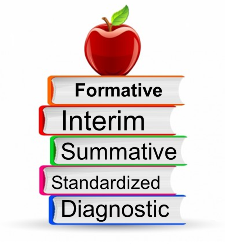Reimagine Learning
Formative, Summative, Standardized? A Guide to Assessment Types
The word assessment has its origins in the Latin verb, assidere, which means “to sit with.” Ideally, this is exactly what an educational assessment does – it sits alongside a student as he or she learns, and gathers useful information about that learning.
There are many forms of assessment, and they can be categorized according to when they are given and how they are used. It can get a bit confusing, so here we will break down several common assessment types found in today’s classrooms:
Formative Assessment: This type of assessment happens during instruction while students are forming new knowledge. Formative assessments are typically short, frequent, and provide students with feedback that can help guide learning. Feedback is provided quickly so that students can course-correct as they learn.

Interim Assessment: Remember the book reports you used to complete in school? A book report is one example of an interim assessment, which takes place over a longer time period than formative assessment. Students are provided feedback after finishing an interim assessment, but typically not as quickly as in formative assessments.
Summative Assessment: Just as the name suggests, this type of assessment examines the sum of student learning. Summative assessments provide stakeholders with information about student learning and performance, but provide little or no feedback. Summative assessments are often used to compare students to other students or a specific standard.
Standardized Assessment: This is the type of assessment most often discussed in the news. There two sub-categories of standardized assessments. Norm-referenced assessments compare students against a group average in order to rank student performance. Criterion-referenced assessments, on the other hand, compare students to a specific goal (think those “chapter tests” you used to take in school).
Diagnostic: Used to understand what students already know and can do, diagnostic assessments are often given at the beginning of a new unit or at the start of an academic year. Many educators also use these results for comparison to performance at the end of a unit of study.
To learn about an incredible new trend in assessment, be sure to stay tuned for the next post in this series!
You might also find these articles interesting:
Categories
- Accessibility (5)
- Blog (48)
- E-Learning and Serious Games (16)
- Election Edge (8)
- Guest Blogger (1)
- Learning Design (11)
- News (12)
- Primary Sources (8)
- Remote Learning (3)
- Second Avenue Voices (13)
- Teacher Tools (10)
- Technology (4)
- Uncategorized (9)
- Webinar (11)
